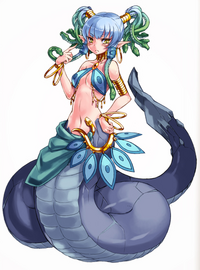Medusa
 | This article or section is about Monstergirls (or a monster that is frequently depicted as a Monstergirl), something that /tg/ widely considers to be the purest form of awesome. Expect PROMOTIONS! and /d/elight in equal measure, often with drawfaggotry or writefaggotry to match. |

Medusa was a woman in Greek mythology who was extremely beautiful. One of her suitors was Poseidon, the god of the sea, and one day he realized that, since he was a god, he didn't have to ask for her permission before having his way with her. So he did, right in the middle of the temple to Athena where she worked. Athena was naturally furious, but since she couldn't do anything to Poseidon, him being a god as well, she vented on Medusa herself - though this has the unfortunate implication of seeming as though Athena punished Medusa for having the audacity to be raped in one of her temples. Either way, she went and turned Medusa into a Gorgon, a monster with snakes for hair and a face so hideous that anyone who looked at it turned to stone. Greek gods are dicks.
[Some alternative versions suggest that A) the sex was fully consensual; B) Athena actually changed her to protect her from future rapes; C) Medusa and her fellow gorgons were either from the underworld or the daughters of sea gods; or D) they were just holdovers from even older religions, but Greek canon is a clusterfuck and Greek rape cases (and justice in general) were excuses for orators to verbally jerk off, so most people stick to the Athenian write-up.]
The myths said that her face was so ugly it turned people to stone (she was basically a shrieking fanged corpse covered in snakes), but most artistic depictions and almost all modern re-tellings have her looking rather beautiful, making her one of the first monstergirls. Also, while Medusa's sisters were changed into Gorgons just like her, Medusa is said to be the only one with the petrifying power, which is something that has become often conflated with the Gorgon race as a whole. That, or they all had that ability, but Medusa was the only one who could be killed. Like we said, it's a clusterfuck.
Dungeons & Dragons
Medusa was a person, not a species (she is a Gorgon), but that didn't stop the writers of Dungeons & Dragons from naming a whole race after her. "Medusae" vary a fair amount depending on which edition you look at.
2e: Medusae look like elven women with snakes for hair and white eyes. They tend to rely on mating with human men to have more medusa daughters, since actual men of their race (called "maedar") are rare as fuck (to the point that most in-universe experts have never heard of them) and the bizarre-ass nature of their reproduction keeps them that way... what? You want to know the details? Alright, it works like this: human man plus medusa equals 2-6 eggs, all of which hatch into medusa daughters. Maedar + medusa, on the other hand, equals 2-6 eggs, of which 25% will hatch into boys. Of those boys, ONE PERCENT are maedar in turn; the other boys, and all the girls, are humans (who, unfortunately, are not immune to their mother's gaze). Medusa and maedar are extremely sexually dimorphic; medusae have snake hair and petrifying gazes, maedar are bald and can turn stone to flesh with a touch. There's also greater medusae, who have snake-bodies instead of legs (like a Lamia) and super-poisonous blood, and glyptars, which are undead maedar whose souls possess crystals, which can be attached to statues (to make golems) or swords (to make intelligent magical weapons).
3e: Medusae are covered in scales and, in most official artwork, tend to look rather ugly. There's no mention of maedar existing in any official sourcebook, but they were updated to 3.5 in the article "Creature Catalog" in Dragon Magazine #355.
4e: As in 3e, medusaea are all scaly, though not actually that ugly. Male medusae have returned, but don't have their own name, are just as scaly and don't turn stone to flesh anymore; instead, they can poison anyone they look at. In the "Monster Vault", the Essentials rewrite of the first 4e Monster Manual with expanded fluff, it was stated that although there are roughly equal numbers of males and females, they're still a matriarchal species, and this is because only a minority of males are actually immune to the petrifying gaze of the females. They're also reputed to be tied to either Zehir or to the Yuan-ti, with one story claiming they were created by yuan-ti crossbreeding with basilisks.
5e: Medusae can be male or female now. New origins as humans who made pact with demonlords or archdevils for eternal beauty, which they got, for a time, before they were turned into snake-haired monsters. Petrifying gaze is the norm for both sexes, but they gotta avoid polished surfaces and bright light, as their own reflections can petrify them as well. In melee, they can bite with their snakes or use weapons, typically shortswords and longbows.
PF: Medusas are back to being 2e-style beautiful women with snake hair who mate with human men to procreate. There's also a related monster in the Eurayle, a mythically powerful analogue to 2e's Greater Medusa who has far nastier powers, not least of which is that she's an 18th level Oracle.
In the Odyssey of the Dragonlords setting, medusae have the standard 5e lore - in fact, the first medusa was a woman named Medusa, who came to Thylea from "the land of the Gorgons" seeking material wealth, only to be cursed by the Fates for her insistence on pursuing it. Aside from explicitly being able to pass on their condition by having children, the only real change for Thylean medusae is that they are a playable race for some reason, with the following stats:
- Ability Score Modifiers: +2 Dexterity, +1 Intelligence
- Size: Medium
- Speed: 30 feet
- Vision: Darkvision 60 feet
- Unaging: Medusae do not have a known lifespan; they live until they are killed.
- Cursed: You are considered to have undergone the complete Curse of the Medusa, and as such cannot be subjected to another transformative curse. You can only be cured by means of a Wish spell, and will revert to your original race if this happens.
- Snake Blood: You have Advantage on saves against spells and abilities that inflict the Poisoned condition.
- Snake Hair: You can attack with your snake hair. This is a melee weapon attack with an attack bonus equal to your proficiency modifier + your Dexterity modifier. It does 1d6 piercing damage on a hit, and your target must make a DC 12 Constitution saving throw or else they are poisoned until the beginning of your next turn.
- Petrifying Gaze: Starting at 5th level, you can use your action to force a creature within 30 feet that can see your eyes to make a DC 8 Constitution saving throw. On a failure, the creature is paralyzed until the end of its next turn. On your turn, you can use your bonus action to force the same creature to repeat this saving throw with disadvantage. Each time it fails, it is paralyzed again until the end of its next turn. When a creature is paralyzed in this way for the third time in a span of 10 minutes, it is instantly petrified. Starting at 10th level, the DC for this saving throw increases to 10. At 15th level, the DC increases to 12. At 20th level, the DC increases to 14.
Magic: The Gathering
Magic: The Gathering also features medusaes, although it calls them "Gorgons". Considered a Creature type, MtG gorgons have an affinity with Black Mana and are found on the planes of Dominaria, Shandalar, Ravnica and Theros. They have the ability to petrify other creatures that meet their gaze; although this is a triggerable ability, meaning they can turn it on and off, it's not a targetable one, meaning that when a gorgon's got her petrifying gaze on, she's dangerous to everyone in the vicinity. It's possible to use severed gorgon heads as weapons that retain this property, as shown by the cards "Gorgon Flail", "Gorgon's Head" and "Felhide Petrifier".
What makes the gorgons of MtG unique is that many of them they lack the traditional mane of snapping serpents; instead, they have serpent tails for hair, giving them prehensile tendril-locks that they have been known to use as limbs or even weapons. A few of the traditional snake heads for hair gorgons have shown up, but they're a distinct rarity. Additionally, the gorgons of Theros have the lower bodies of giant snakes, in the traditional lamia format.
Theros is also home to a gorgon goddess; Pharika, Goddess of Affliction, who is said to be the mother of all gorgons.
The most famous gorgon in MtG is Vraska, a Ravnican planeswalker whose spark ignited when she was falsely imprisoned and subjected to torturous ill-treatment. A deadly assassin and self-style vigilante, she is aligned to both Black and Green Mana, which is only natural given her origins amongst the Golgari Swarm, and is known to relish murdering criminals with particularly ironic methods: her personal philosophy is "A person should die the death they deserve." She is one of the planeswalkers associated with the 2017-2018 Ixalan storyline, where she expresses an attraction to the human planeswalker Jace Beleren. Which is ironic because they first met when Vraska tried to blackmail/intimidate Jace into using his powers as the Guildpact of Ravnica to help her with her own plans to seek revenge amongst the guildleaders of Ravnica for their many crimes against her people. This led to a duel that Vraska lost.
A handful of gorgon cards do depict them with the traditional "snake-head hair" look, but these are uncertain canonicity.
Warhammer Fantasy
In Warhammer Fantasy, the 8th edition update for the Dark Elves saw the release of a new unit called the Bloodwrack Medusae; former Druchii Sorceresses of Ghrond who sought to use their magic to become beautiful, until they angered the jealous goddess Atharti and were transformed into gore-slicked, painwracked monsters, with tresses of writhing serpents and a giant snake's tail replacing their lower torso. Driven mad and reduced to feral beasts, Morathi drove them from the city, but they occasionally show up alongside Druchii armies - either chained to Atharti's Bloodwrack Shrines, or having been drawn from their cavern lairs by the promise of victims to take their pain out on.
They're called "bloodwrack" medusae because their gaze attack doesn't petrify - it exsanguinates, causing a victim's blood to painfully erupt from their skin until they collapse in a gore-drenched heap.
They will be returning in Age of Sigmar as part of the new Daughters of Khaine faction, evidently having regained most of their sanity and now serving as the high priestesses of Morathi, who is herself a Medusa right down to the petrifying gaze and snakes for hair. They are particularly close to the lamia-like Melusai.
Warhammer 40,000
Warhammer 40,000 has no monsters specifically named "Medusa," but the name is still applied to lots of places and items:
- The Tyranid Hive Fleet Medusa
- The planet Medusa, a Death World and the homeworld of the Iron Hands First Founding Chapter of Space Marines (incidentally, their Primarch, Ferrus Manus, was playfully nicknamed "the Gorgon" by Fulgrim for his lack of aestheticism). Medusa is a tectonically unstable planet with constant volcanic eruptions and so many earthquakes the Iron Hands can't build a single fortress-monastery, rather having each Clan-Company using mobile fortresses known as "Land-Behemoths" (think the size of an Adeptus Mechanicus Ordinatus Engine).
- Medusa V (no relation to the above planet Medusa), the site of Games Workshop's 2006 global campaign, which was conveniently destroyed after the campaign ended, so no matter who won, it would not upset the status quo.
- The Medusa Siege Gun, one of several artillery pieces used by the Imperial Guard, and its main weapon, the Medusa Siege Cannon.
- The Sons of Medusa chapter is named after the planet of Medusa (as they are Iron Hands descendants), though they now live among the asteroids of the Taelus system.
- Medusae, parasites employed by the Dark Eldar that are able to kill with their gaze.
Monstergirls
Being that medusas/gorgons are generally presented as an all-female race and often surprisingly attractive, it should be no surprise that they are extremely popular with monstergirls fans, just like the lamias they often resemble.
Monstergirl Encyclopedia

In the Monster Girl Encyclopedia, the medusa is a snake-haired lamia variant with the ability to petrify and/or paralyze (it's not really clear which) with her gaze. They are classified as extremely tsundere, refusing to verbally admit their deep love for their chosen spouses even as their body language betrays just how much they adore him. They also possess the trademark lamia jealousy and possessiveness. They create magical golden pins which can undo the effects of their gaze; this is a reference to Final Fantasy, where "Golden Pins" were the curative item needed to cure the Petrified condition.
Gallery
-
1e
-
Monstrous Compendium Vol. 1
-
The colorized Medusa from 2e's Monstrous Manual.
-
The 2e Maedar.
-
The 3e rendition of Medusa.
-
The Maedar of 3e, from Dragon #355.
-
A combined pic showing both male and female 4e Medusae.
-
The latest D&D Medusa.
-
Medusa from Pathfinder.
-
Euryale from Pathfinder.
-
Art for the Bloodwrack Medusae in 8th Edition Warhammer Fantasy.
-
One of the first depictions of Vraska, the Gorgon Planeswalker of Magic: The Gathering.
-
Vraska's basic biography.
-
Vraska and Jace did not meet under pleasant circumstances.
-
Card art from one of Vraska's new cards in the Ixalan storyline.
-
Promo art showing Vraska leading her pirate crew in search of the Golden City of Orazca, the most valuable treasure of Ixalan.
-
As God of Affliction on Theros, the divine gorgon Pharika created poison and disease, but also the arts of healing and medicine.
-
Of all the gorgons of Theros, none are as feared as Hythonia the Cruel.
-
Damia is a mysterious gorgon whose arcane knowledge rivals that of any archmage, earning her the nickname "The Sage of Stone". Just don't look into her eyes when you consult her.



















